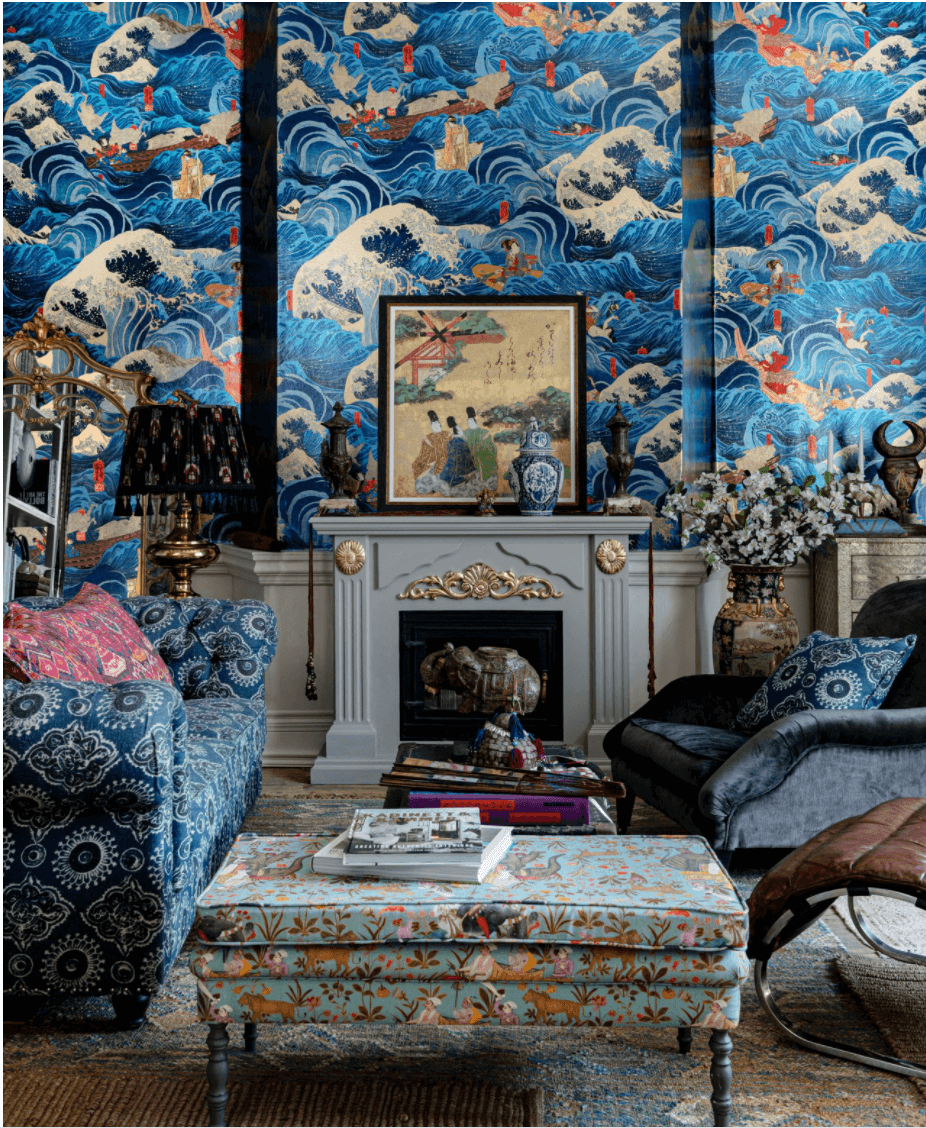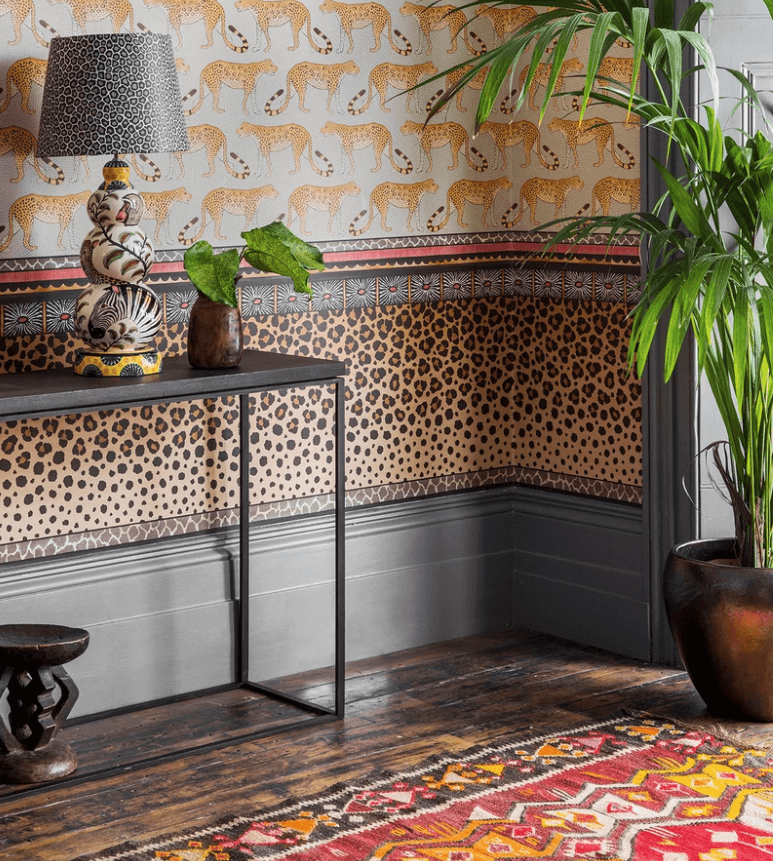What does Maximalism mean?
“Maximalism replicates the rhythm of nature, where there is variation everywhere” is a rather lovely description by curbed.com of one of our favourite design trends.
There is no agreed definition or set of rules for maximalist design so maybe a good place to start is with a look at maximalist meaning’s origins from the wider world.
The Cambridge dictionary definition of Maximalist is “taking as much action or showing as much involvement in a situation as possible”
Collins dictionary defines it as “a member of the radical faction of Social Revolutionaries that supported terrorism”
Definitions.net defines it as “a quality of excessive redundancy oft exhibited by way of the overt accumulation of appurtenances that reflect current society. In other references the term refers to either the ostentatious displays of the extensive possessions of the super-rich or the obsessive collecting as frequently found in the behavior of garage sale shoppers who accumulate common household goods past reason.”
None of these definitions would encourage any rational person to embrace Maximalism as a design style, but in reality it is a lovely trend enabling a lot of personal interpretation and a free rein in terms of colours, styles, pieces and budget for your project.
What does Maximalism look like?
Like us you may well have fallen in love with the interiors in the TV hits Ratched, The Handmaids Tale, The Queens Gambit and The Crown. These interiors all share certain design features – the use of saturated colours, boldly patterned wallpapers, velvets used for upholstery and curtains and personal items spread throughout the rooms giving a flavour of the personality of the inhabitants of that space.
You may not have realised that this is touching on this interior design trend which took off during lockdown but that has had several previous heydays - a design trend called maximalism. The recent lockdowns have definitely played a key part in the resurgence of maximalist design where people have had time on their hands and the desire to create an exciting and stimulating world within their own home. It was a way of reminiscing about a time where there was freedom to travel, shop, eat out and gain new experiences. This is a trend of coveting and shopping; of collecting very personal pieces on your travels and throughout your life; its not an expensive trend and junk shops will likely have as many suitable pieces as an exclusive antique centre or interior design emporium. It’s all about enjoyment of the design and aesthetic and a celebration of all things colourful. It’s a fun trend where more is more.
People are not just one thing; they are complicated and complex and multifaceted—and maximalist decor expresses that with it’s focus on curated collections of objects. Fans and critics comment that to look at a maximalist home is to get a sense of what the inside of a person’s brain might look like — the places they’ve visited, their heritage, the random objects they’ve amassed over a lifetime. A positive or a negative depending on whose brain, some might say!
Maximalist design is a movement that has recently gone from niche, being used in top hotels and bars, to mainstream with many houses of all eras up and down the land embracing maximalist style to a greater or lesser degree. Some would say is verging on the gaudy but that’s not necessarily true - its very much a trend based on personal taste and expression. If hot pink is not your thing, you can choose a forest green or deep blue as your chosen main colour.

A common misconception is that maximalist style promotes hoarding of objects and overstuffing rooms in a chaotic way. While it embraces the idea of excess, this is in terms of repetition, patterns, bold colours, intricate graphic details, and unique personal objects. It’s a confident style composed of mixed patterns, excessive, but curated collections, and saturated colours. For those who want to embrace it’s nature of excess they can, but if your style is to be more toned down, this is perfectly acceptable too. Maximalism as a philosophy is not to be confused with accumulating stuff for stuff’s sake, as consumerism is widely regarded as fueling the environmental crisis. It’s about seeing the world with open eyes, and about expressing who you are and what you love.
During the noughties there was a movement championed by professional declutterers such as Marie Condo where we were made to think having more than the bare necessities was almost immoral. However chaotic clutter is very different to maximalist style whereby objects are chosen because they mean something to the owner and are placed within the room to enhance it’s aesthetics, rather than random clutter that someone cannot be bothered to sort through.
How does Maximalism fit into the period house?
The good thing about period interiors and a penchant for maximalist style is that maximalism’s decorative and colourful nature is reminiscent of the stately home interiors and period features that can be found in our wealth of older properties. Traditional interiors, old houses, wood panelling, ornate coving and ceiling roses, skirting boards, picture rails, vibrant original tiled floors, parquet, carpeting, rugs, paintings, dark or bright paint, sumptuous fabrics, brass, tassels, all typical of period houses are perfect maximalist choices, but the bold colours, and modern accents are what elevates them from classic period interior to a maximalist design choice and being bang on trend.
A quick way to inject Maximalist Style without the use of bright colours into an interior is to introduce animal prints such as leopard and snake which can serve as neutral bases for a maximalist space. The colours of the prints themselves aren't over the top, so mixing these patterns can create a maximalist feeling in the room that isn't too loud and obvious.

Using Maximalist style wallpaper can really quickly transform a bog standard room into something fantastic. Generally for a wallpaper to be Maximalist in style, it needs to include at least one but preferably two really bold colours, whether it’s an aqua, blue, pink or forest green. Some of the below rooms illustrate this better than any words could ever do.
Maximalist design with its glorious celebration of decoration and colour has as one of it’s most famous proponents and sources of inspiration Laurence Llewelyn Bowen and his showpiece rooms featured on TV shows such as Changing Rooms from the mid 1980s to the present day. These make overs definitely elicited strong reactions but the good thing about maximalism is that it definitely gets people talking.
How can I feature Maximalist Design in my period house?
The key features of maximalist decor that you can use in your own home are:
- One consistent bold colour running through the rooom that links the pieces together
- Use of bold vibrant colours in luxurious materials – think velvet curtains, wallpapers and upholstery.
- Use of prints and patterns on wallpaper, rugs, soft furnishings. There is a really wide range of maximalist wallpaper available – typically use one or more bold colour/motif.
- Use of statement pieces of furniture such as a velvet sofa, large ornate dresser, mirror, wall art
- Mixing, matching and layering up of textures, patterns and colours
- Decoration and adornment beyond what is necessary.
- Include art, photographs, books, ornaments, ceramics, mementoes, plants. Anything colourful, beautiful and especially objects without function that show off your hobbies, passions, collections and personality.
- Ensure as many spots in the room as possible aren’t left naked
- Use open shelving to show off rather than hide your items especially in your kitchen

Interior Designers tip
To make sure that your interiors still feel connected even with a mix of colours, patterns and textures in the room, you should find a link between pieces to bring the room together. Pick out a colour that really sings for you, such as an emerald green or rich purple from one of the leaves or flowers in a wallpaper print, and then bring those colours onto a chair and a fabulous set of velvet curtains. Look for the shade that will draw the eye from one piece to the next, but always remember symmetry to keep the room looking balanced. When you keep the space symmetrical, you can layer even more and still keep a sense of balance, even in a room that mixes colours and styles broadly.

Be the first to add a comment...